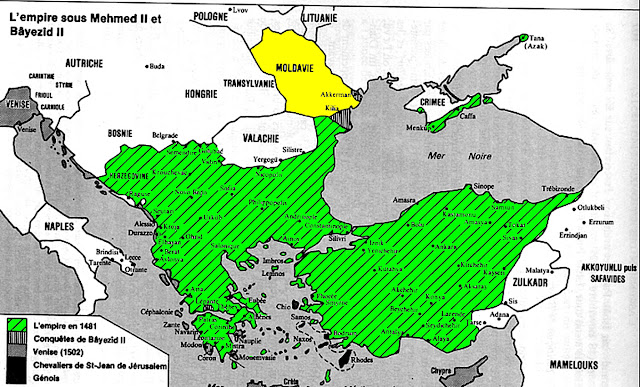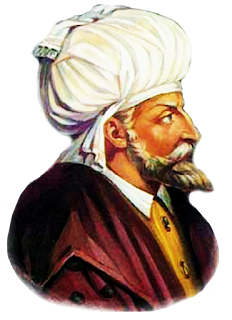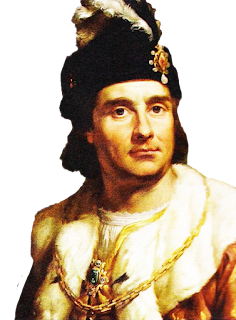Stephen III, surnamed Stephen the Great, was born in 1433 at Borzeşti, and he died on 2 July 1504, at Suceava. Stephen was son of Bogdan II , and was the Prince of Moldavia between 1457 and 1504. He ruled for 47 years, term which has not been equaled in the history of Moldova. In his time, he fought against several neighbors, such as the Ottoman Empire, Kingdom of Poland and Kingdom of Hungary. Churches and monasteries built during his reign are today on the list of world heritage sites.
After his father Bogdan II was killed by Peter Aron, Stephen arrives with his army, aided by Vlad the Impaler, Prince of Wallachia. After defeating Peter Aron at Doljeşti on 12 April and on 14 April 1457 at Orbic he goes to Suceava at a place that is called Direptăţii Plain near the fortress. He asks those present if they want him to be their ruler. Assembly headed by Metropolitan bishop Teoctist, nobles, townsmen, soldiers and "all the country" announce Stephen as ruler of Moldavia.
In April 1459 Stephen recognized the Polish king as suzerain, and left the city of Hotin to him. He promised to personally worship the king when he comes in the border region. The oath was confirmed on 2 March 1462, when the Metropolitan bishop and nobles swore separately obedience to Poland, causing Hungarian king Matthias Corvinus to consider Stephen as treacherous.
In June 1462, Stephen took advantage of the Ottoman offensive started against Wallachia and the Kingdom of Hungary, and unsuccessfully besieged on June 22 the Hungarian garrison of Chilia stationed there after the Hungarian-Moldovan agreement of 1448 between John Hunyadi and Peter II. The failure of the siege was followed by a failure in the military confrontation on the borders of Wallachia. Only in January 1465 Stephen managed to occupy Chilia, with the help of the city townsmen, who were rewarded with privileges.
Relations with the Hungarian king worsened around 1467. Contender to the throne, Peter Aron, was housed for several years in Hungary. King Matthias position against Stephen was unchanged, claiming obedience from the Moldavian prince. Stephen took advantage from the conflict arising between Casimir IV and Matthias Corvinus, King of Poland claiming for himself the crown of Hungary.
In 1467 Stephen supported the uprising of Transylvanian Saxons and nobility against King Matthias. After Matthias regained control of the situation, some of the leaders of the revolt fled to the court of Stephen. Matthias Corvinus took advantage of his arrival in Transylvania from Hungary accompanied by an army composed of 8,000 cavalry and 4,000 infantry, and entered into Moldova in order to settle the Moldavian issue in favor of Hungarian interests. He brought with him two pretenders to the throne. During the Hungarian campaign against him, Stephen also faced an opposition of hostile boyars. After a moment of negotiations at Roman, Hungarian Army robbed the territories through which he passed, and sat at Baia, near the gorges to Transylvania.
On the night of 14 to 15 December 1467 between the Moldovan army, led by Stephen the Great, and the army of the Kingdom of Hungary, led by Matthias Corvinus took place the Battle of Baia. When dusk was approaching, Stephen sent smaller detachments that set the town on fire from three different places. Thereafter, noise and confusion set in. Stephen ordered his men to dismount, and soon after they launched their attack and fight until dawn. Descriptions of the battle say that the fire made the night equally light as the day and that many Hungarians were consumed by the flames. The two armies started to butcher each other at the gate of the city Then the fighting continued onto the streets "with such a wrath, that nothing could be seen as more horrible than this." The Moldavians got the upper hand of the battle and launched another attack against the royal guard, which consisted of 200 heavily armed knights, the aristocrats and Corvinus. Many Moldavians were killed in the tumult that followed, as Báthory and the rest of the knights tried to defend the entrance to the market. Corvinus was wounded by three arrows in the back and had to be “carried from the battlefield on a stretcher, to avoid him falling into the hands of the enemy.”
The retreating Hungarian army, on its way to Transylvania, was stopped by a blockade. There they decided to bury the 500 cannons and other treasures, so the Moldavians would not be able to capture them. Corvinus escaped the Moldavians due to the assistance of another Vlach, whom Stephen found and had executed because of treachery. The Moldavian-German Chronicles say that someone named Isaia failed to launch the cavalry attack which would have blocked the path for the Hungarian retreat For this, he and others were later executed. Around 10,000 Hungarians were said to have been killed but most of the barons escaped with their king. A Hungarian chronicle mentions 7,000 casualties for the Moldavians. This chronicle is disputed though, due to it being the only one mentioning the Moldavian casualties in numbers, and because the Hungarians did not have the opportunity to calculate the numbers of their fallen enemy. The entire conflict, with the Hungarian invasion and retreat, took around forty days.
Matthias Corvinus campaign in Moldova, ended in failure, was the last great attempt to reinstate the suzerainty of the Hungarian crown on Moldova by force. In 1468, Stephen campaigned in Transylvania, found Aron and had him executed. Stephen and Corvinus would later negotiate a peace treaty and become allies. In 1475, Corvinus sent 1,800 soldiers that assisted Stephen in his victory at the Battle of Vaslui.
The following year Stephen confirmed by a new oath of allegiance his obedience to the Polish king, by delegates, but refused to appear in person to Lviv to render homage, citing the threat of an Ottoman, Hungarian or Wallachian attack. In 1469 he robbed the Baia Mare and Rodna regions as retaliation against Hungary for supporting contender Peter Aron.
The first conflict with Wallachia took place in 1462 when, taking advantage of the fact that Vlad the Impaler was at war with the Turks, Stephen attacked the fortress of Chilia. The siege of the city fails, and Stephen is wounded by an arrow in the leg, a wound that will cause gangrene around his death. Stephen conquer Chilia and Cetatea Alba in 1465.
Foreseeing that will soon have to fight the Turks, Stephen wanted to have a friend ruler in Wallachia, instead of a Turkish vassal, Radu the Handsome. In 1470 Stephen began hostilities, despoiling Ialomita and Braila. The Turks sent in response the Tatars in Moldova, but Stephen defeated them at Lipnic, on the Dniester. After other clashes with Radu the Handsome, he fled to the Turks. In November 1473, Stephen conquered the city of Dambovita and put his ally, Laiotă Basarab, as a ruler. But after two years Laiotă Basarab betrays.
Of the 47-year reign Stephen had war with the Turks within 10 years (1474-1484) and after 1484 permanently lost Chilia and Cetatea Alba cities and returned to pay tribute. Mehmed II did not want to leave unpunished mixture of Stephen the Great in the affairs of Wallachia. Therefore, in the winter of 1474 he sent Süleyman Paşa to Moldova, with 120,000 people, with a mission to subdue the ruler and his army and to destroy them. Stephen organize his camp in front of Vaslui in a place called Podul Inalt. The area was ideal for the defenders: the valley was a semi-oval surrounded on all sides by hills covered by forest. Inside the valley, the terrain was marshy, which restricted troop movement. Suleiman had full confidence in his troops and made few efforts to scout the area.
On January 10, on a dark and misty Tuesday morning, the battle began. The weather was frigid, and a dense fog limited vision. The Ottoman troops were exhausted. Stephen fortified the bridge, while setting and aiming his cannons at the structure. Peasants and archers were hidden in the forest, together with their Prince and his boyar cavalry. The Moldavians made the first move by sending musicians to the middle of the valley. The sound of drums and bugles made
Suleiman think that the entire Moldavian army awaited him there. Instead, the centre of the valley held the Székely forces and the Moldavian professional army, which were ordered to make a slow retreat when they encountered the enemy. Suleiman ordered his troops to advance and, when they made enough progress, the Moldavian artillery started to fire, followed by archers and handgunners firing from three different directions. The Moldavian light cavalry then helped to lure the Ottoman troops into the valley by making hit-and-run attacks. Ottoman cavalry tried to cross the wooden bridge, causing it to collapse. Those Ottoman soldiers who had managed to survive the attacks from the artillery and the archers, and who did not get caught in the marshes, had to confront the Moldavian army, together with the Székely soldiers further up the valley. The 5,000 Székely soldiers were successful in repelling the 7,000 Ottoman infantrymen. Suleiman tried to reinforce his offensive, not knowing what had happened in the valley, but then Stephen, with the full support of his boyars, ordered a major attack. All his troops, together with peasants and heavy cavalry, attacked from all sides. Simultaneously, Moldavian buglers concealed behind Ottoman lines started to sound their bugles, and in great confusion some Ottoman units changed direction to face the sound. When the Moldavian army hit, Suleiman lost control of his army. He desperately tried to regain control, but was later forced to signal a retreat. The battle lasted for four days, with the last three days seeing the fleeing Ottoman army being pursued by the Moldavian light cavalry and the 2,000-strong Polish cavalry until they reached the town of Obluciţa (now Isaccea in Romania), in Dobruja.
Stephen inflicted a decisive defeat on the Ottomans, described as "the greatest ever secured by the Cross against Islam," with casualties, according to Venetian and Polish records, reaching beyond 40,000 on the Ottoman side.
In the following year, Mehmed invaded the country with an army of 150,000, which was joined by 10,000 Wallachians under Laiotă and 30,000 Tatars under Meñli I Giray. The Tatars, who called for a Holy War, attacked with their cavalry from the north and started to pillage the country. The Moldavians took chase after them, and routed and killed most of them. In July 1476, after killing 30,000 Ottomans, Stephen was defeated at the Battle of Valea Albă. However, the Ottomans were unsuccessful in their siege of the Suceava citadel and the Neamţ fortress, while Laiotă was forced to retreat back to Wallachia when Vlad and Stefan Báthory, Voivode of Transylvania, gave chase with an army of 30,000. Stephen assembled his army and invaded Wallachia from the
north, while Vlad and Báthory invaded from the west. Laiotă fled, and in November, Vlad the Impaler was installed on the Wallachian throne. He received 200 loyal knights from Stephen to serve as his loyal bodyguards, but his army remained small. When Laiotă returned, Vlad the Impaler went to battle and was killed by the Janissaries near Bucharest in December 1476. Laiotă again occupied the Wallachian throne, which urged Stephen to make another return to Wallachia and dethrone Laiotă for the fifth and last time, while Ţepeluş, was established as ruler of the country.
In 1484, the Ottomans under Bayezid II, managed to conquer Chilia and Cetatea Albă and incorporate them into their empire under the name of Budjak, leaving Moldavia a landlocked principality for many years to come.
After 1489, Stephen’s relations with Poland have worsened because of the Moldavian prince obedience to the king of Hungary. Polish King John Albert hasn’t dropped the plans to return Moldova under his obedience. In 1494 he planned the replacement of Stephen with Sigismund, the younger brother of the King of Poland. Polish official pretext of the campaign in Moldova in 1497 was the release of Chilia and Cetatea Alba. They tried to siege Suceava but they failed. At the same time, Stephen was helped by 2,000 Turkish soldiers and 12,000 Hungarians. In front of military and diplomatic pressure, John Albert of Poland abandoned the plan to remove the Moldavian ruler. On the wayhome, Stephen attacked the Polish king in Codrii Cosminului on October 26th 1497. In retaliation, the following year Stephen sent armies to plunder in Poland. After repeated exchanges of messages in 1499 was signed a peace between Moldova and Poland.
Last years of reign were years of peace. He built 44 monasteries and churches, according to tradition, after each battle won he built a church. In 1462, during the assault of Chilia Nouǎ, Stephen was shot in the leg. The wound never fully healed. In 1486, during the battle of Șcheia, his horse was injured. They both fell and Stephen was trapped under the horse. The incident aggravated his old leg injury. Towards the end of his life, Stephen suffered from gout, which immobilized his hands and legs. On June 30, 1504 Stephen's wound was cauterized by the doctors present in Suceava. The operation caused great pain to him before he died on the morning of 2 July. On his deathbed, he had urged Bogdan to continue to pay the tribute to the sultan. Stephen died after a long reign of 47 years - unusual for those times. Stephen was buried in the Monastery of Putna.












